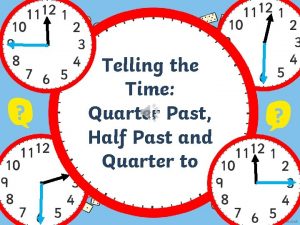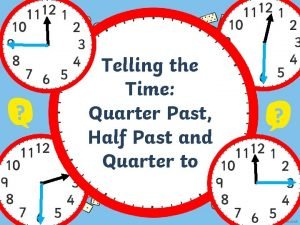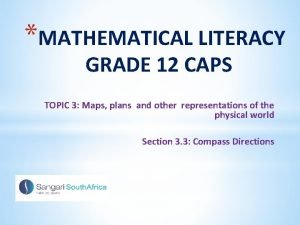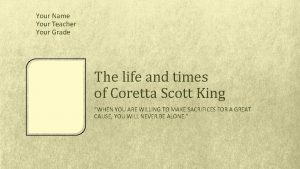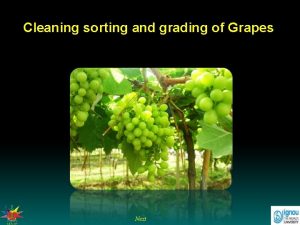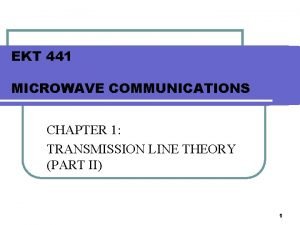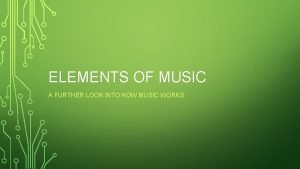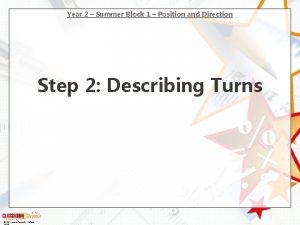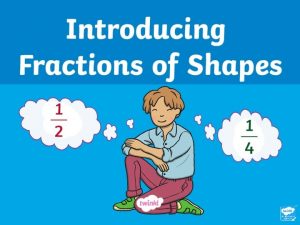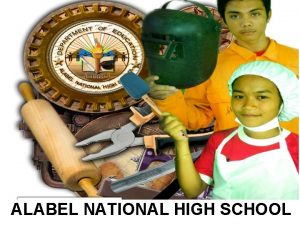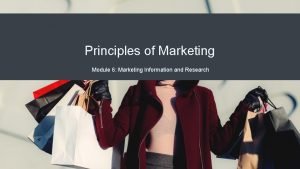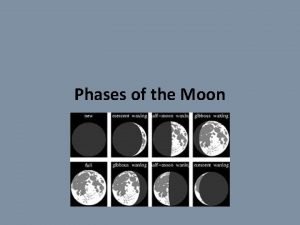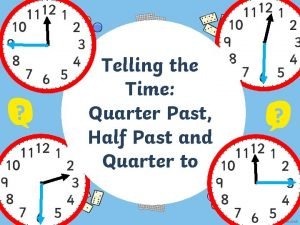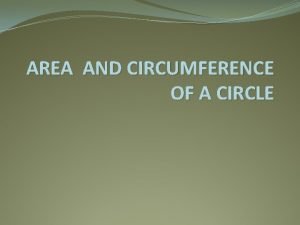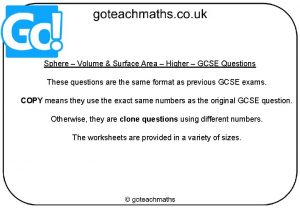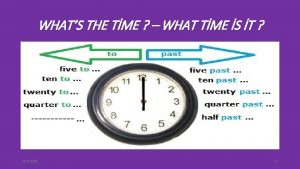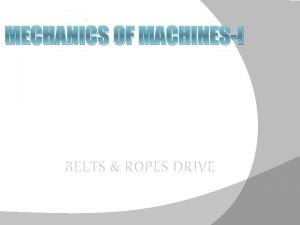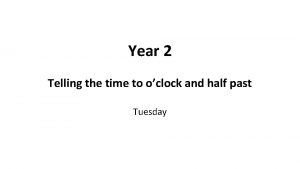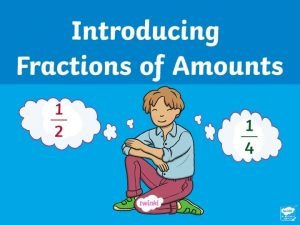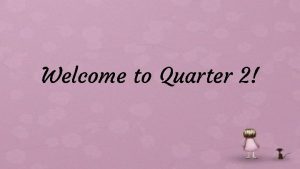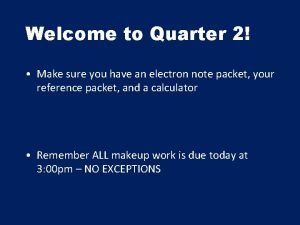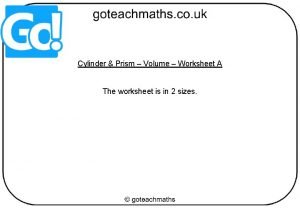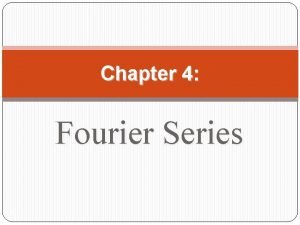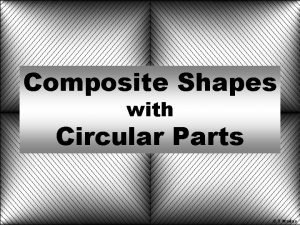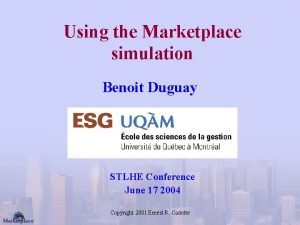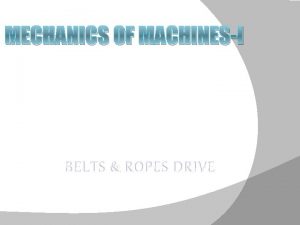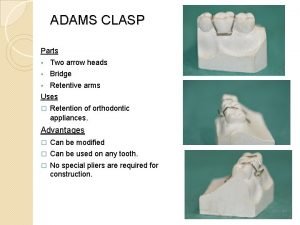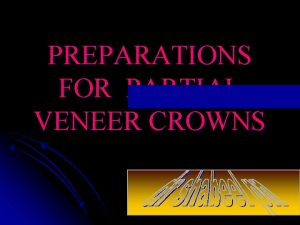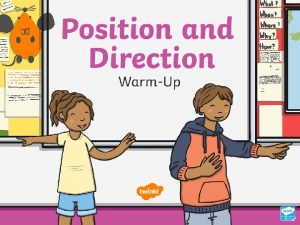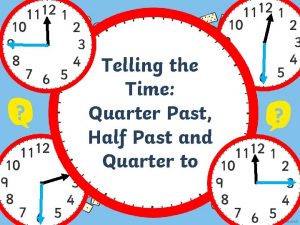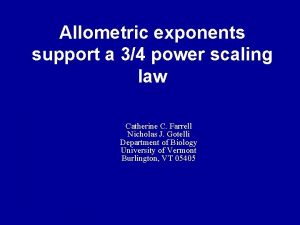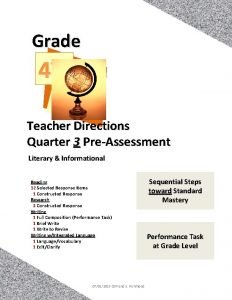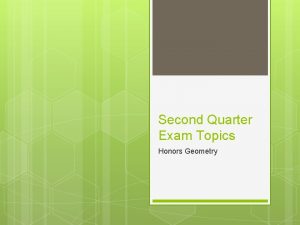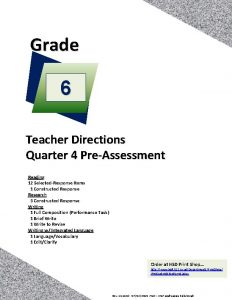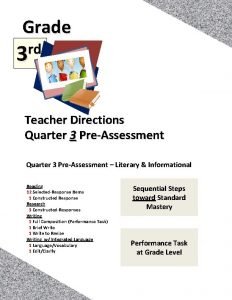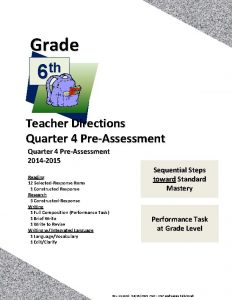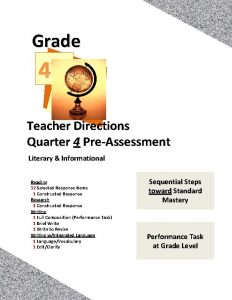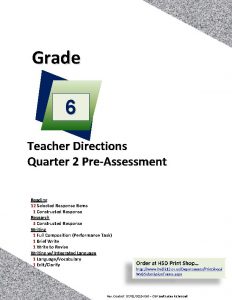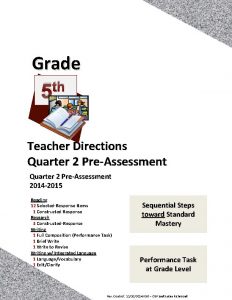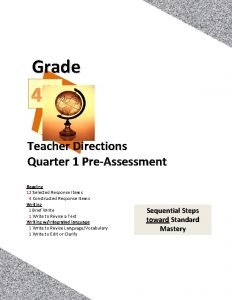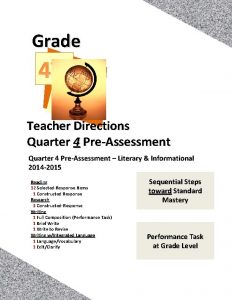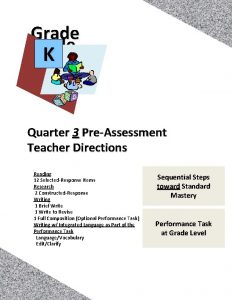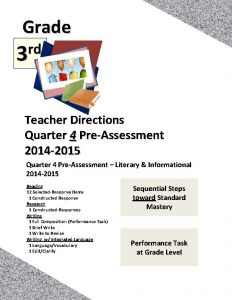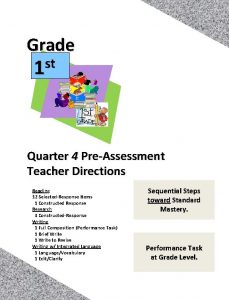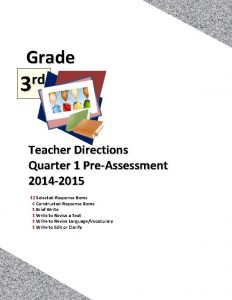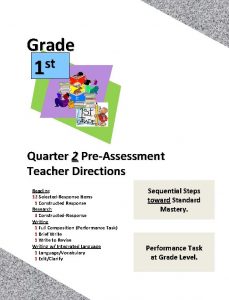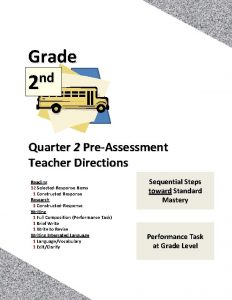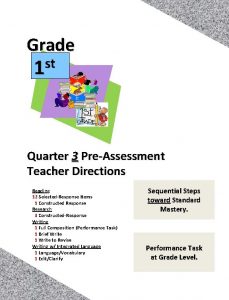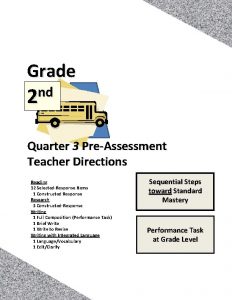Grade th 5 Teacher Directions Quarter 2 PreAssessment














































- Slides: 46

Grade th 5 Teacher Directions Quarter 2 Pre‐Assessment Reading 12 Selected‐Response Items 1 Constructed Response Research 3 Constructed‐Response Writing 1 Full Composition (Performance Task) 1 Brief Write 1 Write to Revise Writing w/ Integrated Language 1 Language/Vocabulary 1 Edit/Clarify Sequential Steps toward Standard Mastery Performance Task at Grade Level Rev. Control: 01/07/2015 HSD – OSP and Susan Richmond

Quarter Two ELA Pre-Assessment Teacher Directions th 5 Reading: Literature Targets Standards DOK 4 Reasoning & Evaluation RL. 5. 6 3‐ 4 5 Analysis Within or Across Texts RL. 5. 6, Rl 5. . 7 3‐ 4 6 Text Structures/Features Rl. 5. 5 2‐ 3 Reading: Informational Targets Standards DOK 4 Reasoning & Evaluation RI. 5. 6 3‐ 4 5 Analysis Within or Across Texts RI. 5. 7 2‐ 3 6 Text Structures/Features Rl. 5. 5, RI. 5. 7 2 Note: There may be more standards per target. Writing standards assessed in this assessment are boxed. Informational Writing and Language Targets Standards DOK 3 a Brief Informational Write W. 2 a, W. 2 b, W. 2 d, W. 2 e and/or W. 9 3 3 b Write‐Revise Informational W. 2 a, W. 2 b, W. 2 c, W. 2 d, W. 2 e and/or W. 9 2 4 Full Informational Composition W‐ 2 a, W‐ 2 b, W‐ 2 c, W‐ 2 d, W‐ 2 e, W ‐ 3 b, W‐ 4, W‐ 5, W‐ 8, W‐ 9 4 8 Language‐Vocabulary Use L. 3 a 1‐ 2 9 Edit and Clarify L. 2 b 1‐ 2 Rev. Control: 01/07/2015 HSD – OSP and Susan Richmond

All elementary ELA assessments were reviewed and revised in June of 2015 by the following amazing and dedicated HSD K‐ 6 th grade teachers. Deborah Alvarado Lincoln Street Ko Kagawa Minter Bridge Linda Benson West Union Jamie Lentz Mooberry Anne Berg Eastwood Sandra Maines Quatama Aliceson Brandt Eastwood Gina Mc. Lain TOSA Sharon Carlson Minter Bridge Teresa Portinga Patterson Deborah Deplanche Patterson Judy Ramer Consultant Alicia Glasscock Imlay Sara Retzlaff Mc. Kinney Sonja Grabel Patterson Jami Rider Free Orchard Megan Harding Orenco Kelly Rooke Free Orchards Renae Iversen Teacher Mentor Angela Walsh Witch Hazel Ginger Jay Witch Hazel Performance Task Classroom Activities for K – 6 were written by Jamie Lentz, Gina Mc. Lain, Hayley Heider, Anna Wooley, Gretchen Erlandsen, Deborah Deplanche, Connie Briceno, Judy Ramer, Carrie Ellis, Sandra Maines, Renae Iversen, Anne Berg, Aliceson Brandt and Ko Kagawa. Rev. Control: 01/07/2015 HSD – OSP and Susan Richmond 3

Possible Background Information for the Teacher… http: //www. msnucleus. org/membership/html/k-6/rc/pdf/rc 5 rock. pdf http: //www. nps. gov/cave/forteachers/upload/geology_ms_gravel. pdf Great photographs: http: //pubs. usgs. gov/bul/0760 c/report. pdf This is a pre-assessment to measure the task of writing an informational article. Full compositions are always part of a Performance Task. A complete performance task would have: Classroom Activity (30 Minutes) Part 1 (35 minutes – Independent work) • Passages or stimuli to Read • 3 Research Questions • There may be other constructed response questions. Part 2 • A Full-Composition (70 Minutes) Students should have access to spell-check resources but no grammar-check resources. Students can refer back to their passages, notes and 3 research questions and any other constructed responses, as often they’d like. Directions 30 minutes 1. You may wish to have a 30 minute classroom activity. The purpose of a PT activity is to ensure that all students are familiar with the concepts of the topic and know and understand key terms (vocabulary) that are at the upper end of their grade level (words they would not normally know or are unfamiliar to their background or culture). The classroom activity DOES NOT pre-teach any of the content that will be assessed! 35 minutes 2. Students read the passages independently. If you have students who can not read the passages you may read them to those students but please make note of the accommodation. Remind students to take notes as they read. During an actual SBAC assessment students are allowed to keep their notes as a reference. 3. Students answer the 3 research questions or other constructed response questions. Students should also refer to their answers when writing their full informational piece. 15 minute break 70 Minutes 4. Students write their full composition (informational piece). SCORING An Informational Rubric is provided. Students receive three scores: 1. Organization and Purpose 2. Evidence and Elaboration 3. Conventions Rev. Control: 01/07/2015 HSD – OSP and Susan Richmond 4

Order at HSD Print Shop… http: //www. hsd. k 12. or. us/Departments/Print. Shop/ Web. Submission. Forms. aspx The HSD Elementary assessments are neither scripted nor timed assessments. They are a tool to inform instructional decision making. It is not the intent of these assessments to have students “guess and check” answers for the sake of finishing an assessment. All students should “move toward” taking the assessments independently but many will need scaffolding strategies. If students are not reading at grade level and can’t read the text, please read the stories to the students and ask the questions. Allow students to read the parts of the text that they can. Please note the level of differentiation a student needed. About this Assessment This assessment includes: Selected-Response, Constructed-Response, and a Performance Task. Types of SBAC Constructed Response Rubrics in this Assessment http: //www. livebinders. com/play? id=774846 Reading • 2 Point Short Response • 3 Point Extended Response Writing • 4 Point Full Composition Rubric (Performance Task) • 2 -3 Point Brief Write (1 -2 Paragraphs) Rubric • 2 -3 Point Write to Revise Rubrics if a CR Research • 2 Point Rubrics Measuring Research Skill Use Quarter 2 Performance Task The underlined sections are those scored on SBAC. Please take 2 days to complete performance tasks. Part 1 • • Part 2 Classroom Activity if Desired/Needed Read two paired passages. Take notes while reading (note-taking). Answer SR and CR research questions about sources Components of Part 1 Note‐Taking: Students take notes as they read passages to gather information about their sources. Students are allowed to use their notes to later write a full composition (essay). Note-taking strategies should be taught as structured lessons throughout the school year in grades K – 6. A teacher’s note‐taking form with directions and a note‐ taking form for your students to use for this assessment is provided, or you may use whatever formats you’ve had past success with Please have students practice using the note-taking page in this document before the actual assessment if you choose to use it. Research: In Part 1 of a performance task students answer constructed response questions written to measure a student’s ability to use research skills needed to complete a performance task. These CR questions are scored using the SBAC Research Rubrics rather than reading response rubrics. • • • Plan your essay (brainstorming -pre-writing). Write, Revise and Edit (W. 5) Writing a Full Composition or Speech Components of Part 2 Planning Students review notes and sources and plan their composition. Write, Revise and Edit Students draft, write, revise and edit their writing. Word processing tools should be available for spell check (but no grammar check). Full Written Informational Composition • introduction (identifies the topic and provides a focus) • organization (definition, classification, comparison/contrast, etc. ), • development (with facts, concrete details, quotations, other information) • transitions (linking ideas) • precise language and domain‐specific vocabulary • conclusion (closure) • Conventions of Standard English. There are NO Technology‐enhanced Items/Tasks (TE) Note: It is highly recommended that students have experiences with the following types of tasks from various on‐line instructional practice sites, as they are not on the HSD Elementary Assessments: reordering text, selecting and changing text, selecting text, and selecting from drop-down menu Rev. Control: 01/07/2015 HSD – OSP and Susan Richmond

Discovering Caves Performance Task Classroom Activity This classroom pre-activity follows the Smarter Balanced Assessment Consortium general design of contextual elements, resources, learning goals, key terms and purpose [http: //oaksportal. org/resources/] The classroom activity was written by Renae Iversen and Sandy Maines. The Classroom Activity introduces students to the context of a performance task, so they are not disadvantaged in demonstrating the skills the task intends to assess. Contextual elements include: 1. an understanding of the setting or situation in which the task is placed 2. potentially unfamiliar concepts that are associated with the scenario 3. key terms or vocabulary students will need to understand in order to meaningfully engage with and complete the performance task The Classroom Activity is also intended to generate student interest in further exploration of the key idea(s). The Classroom Activity should be easy to implement with clear instructions. Please read through the entire Classroom Activity before beginning the activity with students to ensure any classroom preparation can be completed in advance. Throughout the activity, it is permissible to pause and ask students if they have any questions. Resources needed: • http: //www. tubechop. com/watch/6414909 (Mammoth Cave) • http: //www. tubechop. com/watch/6414911 (Oregon Cave) • Place to record/display student responses (chart paper, white board, Smart. Board, etc. ) Learning Goals: Students will • know and understand that spelunking is a method of cave exploration • know and understand that caves have specific features Students will understand the key terms: • Exploration- to learn about caves by investigating and studying them • Features- the structures, forms, and appearances of caves Note: Definitions are provided here for the convenience of facilitators. Students are expected to understand these key terms in the context of the task, not memorize the definitions. [Purpose: The facilitator’s goal is to help students learn about the features of a cave through exploration. *Facilitators can decide whether they want to display ancillary materials using an overhead projector or computer/Smartboard, or whether they want to produce them as a handout for students. Rev. Control: 01/07/2015 HSD – OSP and Susan Richmond

Title: Discovering Caves Facilitator says: Today, we will get ready for the Carlsbad Caverns Performance Task. First I would like each person to take a moment and think about what you already know about caves or caverns. Have you been in a cave? What did you observe or experience? [Give students 1 minute to recall and think about caves. ] [Choose a few student volunteers to share what they know about caves/caverns with the group. Teacher will record ideas where all students can see them. ] Possible student responses (unscripted): • I’ve been to Oregon Caves. • Caves have water in them. • Caves are large and dark. • Animals hide in them. Facilitator says: Now we are going to watch a video about exploring caves. Observe what the people are doing in the video and be prepared to share your findings with the group. [Show video 1: http: //www. tubechop. com/watch/6414909] Facilitator says: Cave exploration can be exciting and scary! In the video, you saw teenagers exploring, or spelunking, through the Mammoth Cave. Spelunking is the sport or practice of exploring or studying caves. Discussion question: What did you notice about the spelunkers in the video? [Give students 1 -2 minutes to discuss with group/partner. Walk around to ensure students are on task. ] [Teacher will record ideas where all students can see them. ] Possible student responses (unscripted): • They were crawling through tight spaces. • They wore hardhats/helmets with lights on them. • Some of the kids were scared about being in a tight space. Rev. Control: 01/07/2015 HSD – OSP and Susan Richmond

Facilitator says: Next, we are going to watch a video about the formation of caves and their features. Be prepared to share what you learn about the features with the group. [Show video 2: http: //www. tubechop. com/watch/6414911] Facilitator says: The formations in the cavern were unusual-looking. There were several kinds and each were created a different way. Discussion question: What do you recall the tour guide telling us about their creation? [Give students 2 -3 minutes to discuss with group/partner. Walk around to ensure students are on task. ] [Choose a few student volunteers to share what they know about the features in the cave with the group. Teacher will record ideas where all students can see them. ] Possible student responses (unscripted): • Flowstone • Stalactites • Soda Straws • Draperies • General explanation of formation Facilitator says: “In your performance task, you will be learning about The Carlsbad Caverns. The group work you did today should help prepare you for the research and writing you will be doing in the performance task. ” Note: Facilitator should collect student notes from this activity. Rev. Control: 01/07/2015 HSD – OSP and Susan Richmond

Pre‐Assessment and Learning Progressions The pre‐assessments are unique. They measure progress toward a standard Unlike the Common Formative Assessments which measure standard mastery, the pre-assessments are more like a base-line picture of a student’s strengths and gaps, measuring skills and concepts students need “along the way, ” in order to achieve standard mastery. END of Beg. of QTR CFA Example of a Learning Progression for RL. 2. 1 Pre-Assessments Measure Adjustment Points (in purple) RL. 2. 1 grade ‐level standard assessment. After the pre-assessment is given, Learning Progressions provide informal formative assessment below and near grade-level “tasks” throughout each. Throughout quarter. DOK 1 ‐ Ka Recall who, what, where, when, why and how about a story read and discussed in class. DOK ‐ Kc Use and define Standard Academic Language: who, what, where, when, why, and how; ask, answer, questions, key details DOK 1 ‐ Cd Connect the terms who to characters; where and when to setting; what and how to sequence of events. DOK 1 ‐ Cf Ask and answer who, what, where, when, why and how questions about key details in a text. the QTR DOK 2 ‐ Ch Concept Development Student understands that key details help tell who, what, where, when, why and how. DOK 2 ‐ Ck Uses key details to identify who, what, where, when, why and how about a story not read in class. QTR DOK 2 ‐Cl Finds information using key details to answer specific questions about a new story. Standard Mastery RL. 2. 1 Ask and answer such questions as who, what, where, when, why, and how to demonstrate understanding of key details in a text So what about a “post-assessment? ” There is not a standardized post-assessment. The true measure of how students are doing “along the way, ” is assessed in the classroom during instruction and classroom formative assessment. For this reason The CFA’s are not called “post-assessments. ” The CFAs measure the “end goal, ” or standard mastery. However, without the pre-assessments, how will we know what our instruction should focus on throughout each quarter? Learning Progressions: are the predicted set of skills needed to be able to complete the required task demand of each standard. The learning progressions were aligned to Hess’ Cognitive Rigor Matrix. The pre-assessments measure student proficiency indicated on the boxes in purple (adjustment points). These points are tasks that allow us to adjust instruction based on performance. For instance, if a student has difficulty on the first “purple” adjustment point (DOK-1, Cf) the teacher will need to go back to the tasks prior to DOK-1 Cf and scaffold instruction to close the gap, continually moving forward to the end of the learning progression. There is a Reading Learning Progression checklist for each standard in each grade that can be used to monitor progress. It is available at: http: //sresource. homestead. com/Grade-2. html Rev. Control: 01/07/2015 HSD – OSP and Susan Richmond 9

Quarter Two Reading Literature Learning Progressions. The indicated boxes highlighted before the standard, are assessed on this preassessment. The standard itself is assessed on the Common Formative Assessment (CFA) at the end of each quarter. DOK 1 ‐ Ka Recall the events in a story, drama or poem (as read and discussed in class). DOK 1 ‐ Kc DOK 1 ‐ Cd DOK 1 ‐ Cf DOK 2 ‐ Ch Define and Understand the meaning of the Standard Academic Language: series, chapter, scene, stanza, provides, overall, structure, particular drama and poem. Identify basic literary elements within a story, drama (plot, theme, characters, etc. . ) poems (rhyme, alliteration, similes, personification, etc. . . ) and story (character, setting, plot, event, etc. . . ). Answer who, what, when, where or how questions about a story, drama or poem (basic) read but questions not discussed. Concept Development Understands how a chapter is part of a story, a scene part of a drama and a stanza part of a poem DOK 1 ‐ Ka DOK 1 ‐ Kc DOK 1 ‐ Cd Recall basic facts or events from a narration read or discussed in class. Define and Understand the meaning of the Standard Academic Language : speaker, narrator, point of view, influences Identify and describe the characters, setting and sequence of events. Identify characters who are speaking (in a text read and discussed) DOK 2 ‐ Cl DOK 2 ‐ APn Locates informati on within a particular chapter, scene or stanza in order to answer a question. Obtain information within a particular scene, chapter or stanza in order to answer specific questions about a text. DOK 2 ‐ ANr DOK 2‐ 3‐ EVE DOK 3 ‐ SYH Standard Explain how a series of chapters, scenes or stanzas fit together to provide the overall text structure and give an example. Explain how a specific chapter contributes to the structure (event sequence) of a story (continue with scenes and dramas, stanzas and poems). SELECTED RESPONSE Synthesize Information from a stanza, chapter or scene from one source or text to summarize or explain the development of story, drama or poem. SELECTED RESPONSE RL 5. 5 Explain how a series of chapters, scenes, or stanzas fits together to provide the overall structure of a particular story, drama, or poem. ssed Asse t o N DOK 1 ‐ Cf DOK 2 ‐ Ch Answer Concept questions Development that Understands identify a that points of character’s view may point of influence how d view. are eevents s s e s described. ot As N DOK 2 ‐ Cl DOK 3 ‐ Cu DOK 4 ‐ ANQ DOK 4 ‐ EVS Standard Locate information to identify which character is speaking in the first person or third person. SELECTED RESPONSE Use text evidence to explain a character’s point of view. SELECTED RESPONSE Use speaker’s discourse style to help understand their point of view. Justify reasoning behind speaker’s discourse style and how it influences their point of view. CONSTRUCTED RESPONSE RL 5. 6 Describe how a narrator’s or speaker’s point of view influences how events are described. DOK 1 ‐ Ka DOK 1 ‐ Kc DOK 1 ‐ Cf DOK 2 ‐ Ch DOK 2 ‐ Cl DOK 2 ‐ APn Recall basic details or facts about the use of meaning, tone or beauty in a text (read and discussed in class). Define and Understand the meaning of the Standard Academic Language: tone, beauty/effectiveness, visual and multimedia features (such as features presented in graphic novels, multimedia presentations of fiction, folktale, myth or poem). Answer who, what, when, where or how questions about meaning, tone or beauty in a text (read and discussed in class). Concept Development Understands that visual/multimedia elements contribute to the meaning and tone of the piece. Locate examples of visual or multimedia elements that contribute meaning, tone or beauty to a specific text. SELECTED RESPONSE Obtain information from visual or multimedia features that specifically lends an interpretation to the meaning, tone or beauty of a text. DOK 1 ‐ ANo DOK 2 ‐ ANp Identifies what specific visual or multimedia elements represent (meaning, beauty, tone, etc. . . ). SELECTED RESPONSE DOK 3 ‐ EVC Categorizes the identified visual or multimedia features represented in a novel, Cite evidence and develop a logical argument for how the categorized visual or multimedia presentation, elements add to folktale, the meaning, myth or tone, and beauty poem of a text (possible CONSTRUCTED graphic). RESPONSE Rev. Control: 01/07/2015 HSD – OSP and Susan Richmond Standard RL 5. 7 Analyze how visual and multimedia elements contribute to the meaning, tone, or beauty of a text (e. g. , graphic novel, multimedia presentation of fiction, folktale, myth, and poem). 10

Quarter Two Reading Informational Learning Progressions. The indicated boxes highlighted before the standard, are assessed on this preassessment. The standard itself is assessed on the Common Formative Assessment (CFA) at the end of each quarter. DOK 1 ‐ Ka DOK 1 ‐ Kc DOK 1 ‐ Cf DOK 2 ‐ Ch DOK 2 ‐ Ck DOK 2 ‐ APn Locates or recalls basic information in multiple texts regarding concepts, events, ideas, and information (read and discussed in class). Define and Understand the meaning of the Standard Academic Language: text structure (include: compare and contrast, chronology, problem/solution, cause/effect, comparison, etc…), events, ideas and concepts. Answer who, what, when, where or how questions about events, ideas, concepts or information in two or more texts (read but not discussed in class). Concept Development Understands that different texts can have different text structures and explains why. Identify these specific text structures in informational text: chronological order, cause and effect, comparisons, problem and solution DOK 2 ‐ ANp Compare or categorize different text features (i. e. , language) seen in: chronological order, cause and effect, comparisons and problem and solution structures. DOK 2 ‐ ANr Analyze format, organization and internal text structures (signal words, transitions and semantic cues) of different texts. DOK 3 ‐ APx Apply the understanding of studied text structures by determining which text was most effective in presenting events, ideas or concepts (not read or discussed in class). SELECTED RESPONSE DOK 3 ‐ SYh Synthesize how an overall structure is used in the explanation of an event, idea or concept in one text. DOK 4 ‐ SYU Synthesize the text structures in multiple texts in order to compare and contrast (use examples from various texts) to support a specific criteria (i. e. , an opinion or example). SELECTED RESPONSE Obtain information using text structures to answer informational questions (which text structure uses cause and effect to …? etc…). d sesse s A t No Standard RI 5. 5 Compare and contrast the overall structure (e. g. , chronology, comparison, cause/effect, and problem/solution) of events, ideas, concepts, or information in two or more texts. DOK 1 ‐ Ka DOK 1 ‐ Kc DOK 1 ‐ Cf DOK 2 ‐ Ch DOK 2 ‐ Cl DOK 2 ‐ ANp DOK 3 ‐ EVE DOK 4 ‐ ANN DOK 4 ‐ SYV Standard Recall basic facts about a topic or event from multiple accounts (read and discussed in class). Define and Understand the meaning of the Standard Academic Language: point of view, bias, similarities, differences, events, topics, evidence, multiple accounts and represent. Answer specific who, what, when, where or how questions about the same topic or event from multiple accounts (read but the questions have not been discussed in class). Concept Development Understands and recognizes that multiple accounts may have different points about the same topic Find examples of specific points in multiple accounts. Categorize specific points from multiple accounts with similar points of view (no contrasting at this point, just comparing). SELECTED RESPONSE Verify the reasonableness of how specific points from multiple texts are presented (are the points valid? ). Analyze (compare and contrast) multiple accounts of the same event or topic, noting important similarities and differences in the point of view they represent (Venn). SELECTED RESPONSE Synthesize specific points across multiple texts on the same event or topic to articulate a new perspective CONSTRUCTED RESPONSE RI 5. 6 Analyze multiple accounts of the same event or topic, noting important similarities and differences in the point of view they represent. DOK 1 ‐ Ka Locate or recall basic facts in multiple print or digital sources (read and discussed in class). ssed Asse t o N DOK 1 ‐ Kc Define and Understand the meaning of the Standard Academic Language: digital sources, print sources and their uses for locating information (dictionary, atlas, thesaurus, encyclopedia, etc. ). DOK 1 ‐ Cf Answer specific who, what, when, where or how questions about information found in digital or print sources read but not discussed specifically. SELECTED RESPONSE DOK 2 – Ch Concept Development Understands that specific types of information can be found within a print or digital source and gives an example. DOK 2 – Cl Locate specific information in appropriate multiple print or digital sources. SELECTED RESPONSE DOK 2 ‐ APn Using text features efficiently as a guide, obtain and interpret information found in multiple print or digital sources. CONSTRUCTED RESPONSE Standard RI 5. 7 Draw on information from multiple print or digital sources, demonstrating the ability to locate an answer to a question quickly or to solve a problem efficiently Rev. Control: 01/07/2015 HSD – OSP and Susan Richmond 11

Grade 5 Research Notes Teacher Guide R E‐ S E A R SOMETHING NEW EXPLAIN MORE AGAIN and AGAIN RELEVANT OR NOT? C CONCLUDE H HAVE EVIDENCE What problems or questions does the author state about the main idea? students to re‐read and selectthe a paragraph Write one new problem or question the author brings to. Instruct the reader’s attention about main or section of the text with problems or questions topic. about the main topic. Ask, “Does the section or paragraph you chose state _______________________________________ a new question or problem about the main idea? ” idea This is a key detail that may help solve the problem _______________________________________ or answer the question (be sure students can identify the main topic). ” Key Details Have students write ONE brief sentence about a new problem or question the author brings to the from the passage explain more about the problem orabout question? reader’s attention the main idea. What key details Write two key details that provide an answer or a solution. Use Quotes from the text when possible. 1 • Key Detail (has an answer or solution) Ask students to look for key details that explain ____________________________________ more about the problem or question. Remember students will need to have a note‐taking form Explain “Key details about the main idea can help for ____________________________________ each passage. us find answers to a question or solution to a problem. ” problem Instruct students to write 2 brief key details that provide an answer or solution 2 • Key Detail (has an answer or solution) _________________________________________________________________________ Again and Again What words, phrases or ideas does the author use again. Instruct and again? Write students to lookthem at thehere. again and again Think about why the author uses them again and again. words or phrases, ask “Do you see some of the Have students re‐read the paragraph or section they wrote about and write words or ideas they see Again and Again, Again in the box. Explain, “When author’s use the same words, phrases or ideas Again and Again ask yourself “why? ” It means something is important. ” again and again words or ideas in the key details about problems and solutions? Can the words help you write one conclusion sentence that summarizes the problem and solution (or the question and answer)? ” answer) 3 Summarizing is a big part of writing conclusions. It is an extremely important strategy for students to learn in order to use research skills effectively. 4 Differentiation: Students whothat need more pages –the print as many as needed. Students would benefit from enrichment can continue on with more sections or Write one conclusion sentence tells most about thewhonew contribution (key idea). paragraphs. Students who need more direct instruction – teach part as a mini lesson. These concepts can be taught separately: • Main Topic Use some of the again and again words or ideas in your summary. • Problem/solution question/answer • Key Details ______________________________________ • Again and Again • Conclusions ‐ Summarizing ELL Students may need each part taught using language (sentence) frames emphasizing transitional words. _______________________________________ Rev. Control: 01/07/2015 HSD – OSP and Susan Richmond

Grade 5 Research Notes RE S SOMETHING NEW E EXPLAIN MORE A AGAIN & AGAIN R RELEVANT OR NOT? C CONCLUDE H HAVE EVIDENCE Name________ Passage_______ Main Idea________ What problems or questions does the author state about the main idea? Write one new problem or question the author brings to the reader’s attention about the main idea. _____________________________________________________________________________ Key Details What key details from the section or paragraph explain more about the problem or question? Write two key details that provide an answer or a solution. Use quotes from the text when possible. • Key Detail (has an answer or solution) _________________________________________________________________________ Again and Again What words, phrases or ideas does the author use again and again? Write them here. Think about why the author uses them again and again. Write one conclusion sentence that tells the most about the new key idea and the answer and solution key details. Use some of the again and again words or ideas in your summary. _____________________________________________________________________________ Rev. Control: 01/07/2015 HSD – OSP and Susan Richmond

Determining Grade Level Text Grade level text is determined by using a combination of both the CCSS new quantitative ranges and qualitative measures. Example: If the grade equivalent for a text is 6. 8 and has a lexile of 970, quantitative data shows that placement should be between grades 4 and 8. Common Core Band Flesch‐Kincaid® The Lexile Framework® 2 nd ‐ 3 rd 1. 98 ‐ 5. 34 420 ‐ 820 4 th ‐ 5 rd 4. 51 ‐ 7. 73 740 ‐ 1010 6 th – 8 th 6. 51 ‐ 10. 34 925 ‐ 1185 9 th – 10 th 8. 32 ‐ 12. 12 10. 50 ‐ 1335 11 th ‐ CCR 10. 34 ‐ 14. 20 11. 85 ‐ 1385 Four qualitative measures can be looked at from the lower grade band of grade 4 to the higher grade band of grade 8 to determine a grade level readability. Rate your text from easiest to most difficult between bands. 4 Qualitative Factors Beginning of lower (band) grade End of lower (band) grade Beginning of higher (band) to mid End of higher (band) grade Purpose/Meaning Structure Language Clarity Language Overall Placement The combination of the quantitative ranges and qualitative measures for this particular text shows that grade 6 would be the best readability level for this text. To see more details about each of the qualitative measures please go to slide 6 of: http: //www. corestandards. org/assets/Appendix_A. pdf Rev. Control: 01/07/2015 HSD – OSP and Susan Richmond Not suited to band

Grades 3 ‐ 5: Generic 4‐Point Informational/Explanatory Writing Rubric Statement of Purpose/Focus and Organization Score Statement of Purpose/Focus CCSS and Report Card Alignment Text Types & Purposes: 3 rd‐W. 3. 2 a‐b 4 th‐W. 4. 2 a‐b 5 th‐W. 5. 2 a‐b The response is fully sustained and consistently and purposefully focused: 4 • controlling idea or main Development: Language and Elaboration of Evidence Organization CCSS and Report Card Alignment Text Types & Purposes: 3 rd‐W. 3. 2 c‐d 4 th‐W. 4. 2 c‐d 5 th‐W. 5. 2 c‐d CCSS and Report Card Alignment Research to Build and Present Knowledge: 3 rd‐W. 3. 7‐ 8 4 th‐W. 4. 7‐ 9 5 th‐W. 5. 7‐ 9 The response has a clear and effective organizational structure creating unity and completeness: idea of a topic is focused, • use of a variety of clearly stated, and strongly transitional strategies logical progression of ideas from Exemplary maintained. beginning to end. (E) • controlling idea or main idea of a topic is • effective introduction and introduced and conclusion for audience and communicated clearly purpose. within the context. The response is adequately The response has an evident sustained and generally organizational structure and a focused: sense of completeness, though there may be minor • focus is clear and for the flaws and some ideas may be most part maintained, loosely connected: though some loosely related material may be • adequate use of transitional Proficient present. strategies with some variety (M) adequate progression of • some context for the ideas from beginning to end. controlling idea or main idea of the topic is • adequate introduction and adequate. conclusion 3 The response is somewhat sustained and may have a minor drift in focus: 2 Developing (NM) • may be clearly focused on the controlling or main idea, but is insufficiently sustained. • controlling idea or main idea may be unclear and somewhat unfocused. 1 transitional strategies with little variety uneven progression of ideas from beginning to end. • may be very brief may ambiguous. • few or no transitional strategies are evident. • frequent extraneous ideas may intrude. is smoothly integrated comprehensive, and relevant. CCSS and Report Card Alignment Conventions & Vocab. Acquisition: 3 rd‐L. 3. 1 b‐i, L. 3. 3 a & L. 3. 6 4 th‐L. 4. 1, L. 4. 3 a, & L. 4. 6 5 th‐L. 5. 1 b‐e, L. 5. 3 a & L. 5. 6 Conventions CCSS and Report Card Alignment Conventions: 3 rd‐L. 3. 2 4 th‐L. 4. 2, L. 4. 3 b 5 th‐L. 5. 2 The response clearly and effectively expresses ideas, using precise language: The response demonstrates a strong command of conventions: • use of academic and • few, if any, errors are domain-specific vocabulary is clearly appropriate for the audience and purpose. present in usage and sentence formation. • effective and consistent use of punctuation, elaborative techniques. capitalization, and spelling. The response provides The response adequately The response adequate support/evidence for expresses ideas, demonstrates an the controlling idea or main employing a mix of adequate command of idea that includes the use of precise with more conventions: sources, facts, and details: general language. • effective use of a variety of • some errors in usage and • some evidence from sources Use of domain-specific is integrated, though citations vocabulary is generally may be general or imprecise. appropriate for the audience and purpose. • adequate use of some elaborative techniques. • evidence from sources is • conclusion and introduction, if present, are weak. • use of evidence from sources The response provides uneven, cursory support/evidence for the controlling idea or main idea that includes partial or uneven use of sources, facts, and details: • inconsistent use of The response may be The response has little or no related to the topic but may discernible organizational provide little or no focus: structure: Merging have a major drift focus. (NY) • may be confusing or 0 The response has an inconsistent organizational structure, and flaws are evident: The response provides thorough and convincing support/evidence for the controlling idea or main idea that includes the effective use of sources, facts, and details: Language and Vocabulary weakly integrated, and citations, if present, are uneven. • weak or uneven use of elaborative techniques The response provides minimal support/evidence for the controlling idea or main idea that includes little or no use of sources, facts, and details: • use of evidence from the The response expresses ideas unevenly, using simplistic language: • use of domain-specific sentence formation may be present, but no systematic pattern of errors is displayed. • adequate use of punctuation, capitalization, and spelling. The response demonstrates a partial command of conventions: vocabulary that may at • frequent errors in times be inappropriate usage may obscure for the audience and meaning. purpose. • inconsistent use of punctuation, capitalization, and spelling. The response expression The response of ideas is vague, lacks demonstrates a lack of clarity, or is confusing: command of conventions: • uses limited language or domain-specific • errors are frequent vocabulary. and severe. source material is minimal, absent, in error, or irrelevant. • may have little sense of • meaning is often audience and purpose. obscure. A response gets no credit if it provides no evidence of the ability to [fill in with key language from the intended target]. Rev. Control: 01/07/2015 HSD – OSP and Susan Richmond

Listening & reading Productive modalities*: Ways in which students communicate to others (e. g. , speaking, writing, and drawing). Instruction and assessment of productive modalities focus on students’ communication of their own understanding or interpretation. Interactive modalities*: Collaborative use of receptive and productive modalities as “students engage in conversations, provide and obtain information, express feelings and emotions, and exchange opinions” (Phillips, 2008, p. 3). Standard An ELL can… Speaking & Writing Listening, speaking, reading, and writing Productive (S & W) 1 construct meaning from oral presentations and literary and informational text through grade-appropriate listening, reading, and viewing 8 determine the meaning of words and phrases in oral presentations and literary and informational text 3 speak and write about grade-appropriate complex literary and informational texts and topics 4 construct grade‐appropriate oral and written claims and support them with reasoning and evidence 7 adapt language choices to purpose, task, and audience when speaking and writing 2 participate in grade‐appropriate oral and written exchanges of information, ideas, and analyses, responding to peer, audience, or reader comments and questions 5 conduct research and evaluate and communicate findings to answer questions or solve problems 6 analyze and critique the arguments of others orally and in writing By the end of an English language proficiency level, an ELL in grades 4‐ 5 can. . . 1 4 10 ‐ make accurate use of standard English to communicate in grade-appropriate speech and writing Receptive modalities*: Ways in which students receive communications from others (e. g. , listening, reading, viewing). Instruction and assessment of receptive modalities focus on students’ communication of their understanding of the meaning of communications from others. 9 ‐ create clear and coherent grade‐appropriate speech and text ELP 4 th – 5 th Grade Band Standards Organized by Modality …express an …construct grade‐ opinion about a appropriate oral familiar topic. and written claims and support them with reasoning and evidence. 2 3 …construct a simple claim about a familiar topic, and give a reason to support the claim. …construct a claim about familiar topics, introducing the topic and providing a few reasons or facts to support the claim. 4 …construct a claim about a variety of topics: introduce the topic, provide several reasons or facts to support the claim, and provide a concluding statement. 5 …construct a claim about a variety of topics: introduce the topic, provide logically ordered reasons or facts to support the claim, and provide a concluding statement. This performance task is based on writing. As an option if you’d like to monitor growth for ELP as a second goal, teachers can choose to assess ELP standard 4 because it aligns with this specific performance task. Your student’s full composition can be analyzed to identify English language proficiency levels. It is evident that students will be navigating through the modalities to get to the end product. However, it is important to keep in mind what the full opinion writing performance task is assessing and how deeply the student understands class content and language. The ELP growth goal is to provide the “just-right scaffolds” for students to demonstrate their understanding in order for them to move from one proficiency level to the next. Oregon ELP Standards Aligned with Performance Task, 2014; Arcema Tovar Rev. Control: 01/07/2015 HSD – OSP and Susan Richmond

Informational Writing Pre‐Assessment Student and Class Scoring: Scoring Key: Total # Correct 1 = Emerging 0 -4 2 = Developing 3 = Proficient 4 = Exemplary School Year: Grade: Teachers Name: 5 -7 8 - 10 School: 11 - 12 Student Name: Focus and Elaboration and Conventions Organization Evidence Score Student Total Score 1. 2. 3. 4. 5 0 6 0 7 0 8 0 9 0 10 0 11 0 12 0 13 0 14 0 15 0 16 0 17 0 18 0 19 0 20 0 21 0 22 0 23 0 24 0 25 0 26 0 27 0 28 0 29 0 30 0 31 0 32 0 33 0 34 0 35 0 Rev. Control: 01/07/2015 HSD – OSP and Susan Richmond ELP Score

A Note about constructed responses: Constructed response answers are not written “in stone. ” There is no perfect way a student should respond. Look for the general intent of the prompt and student response and follow the rubric below as much as possible. Use your best judgment. Unlike DOK-1 questions where there is one right and wrong answer, constructed responses are more difficult to assess. Overall consistency of intent based on most of your student responses can guide you. Quarter 2 Pre‐Assessment Research Constructed Response Answer Key Constructed Response Research Rubrics Target 2 RL. 5. 6 Locate, Select, Interpret and Integrate Information. Question #7 Prompt: How is the statement “I was sad to leave but we were both excited to get back home and tell our friends about our adventure, ” an example of the speaker’s point of view? Use specific details from the text to support your explanation. Teacher /Rubric “Language Response” The response gives sufficient evidence of the ability to locate and select information that supports the idea that first person descriptions help the reader understand the experience of speaker. Such evidence could include: (1) the speaker’s explanations of wanting to go in a cave like her parents, (2) the speaker’s descriptors about wanting to have an adventure, (3) descriptors of details about the cave (height of trip back, features of cave) and (4) details about swallows (how they are banded, migration). Students can include any other examples that illustrate the experience of the speaker. The response gives sufficient evidence of the ability to interpret and integrate information about the speaker’s desire to tell her friends about her adventure with her experience in the caves. Such details could include, (1) the speaker’s assertion that she wanted to have an adventure like her parents, (2) any of the supporting details about the speaker’s excitement about the trip, (3) speaker’s statement that she had a lot of information to share with her friends, (4) the speaker’s statement about looking forward to returning home, (5) any supported inferences about wanting to share her adventure with her friends. Student “Language” Response Example 2 The student locates and selects information to support the idea that story is told in first person to allow us to experience the point of view of the speaker as she has an adventure. The daughter always wanted to go on an adventure in a cave with her parents who were spelunkers. When she found out that they were going to a cave, she and her sister were so excited they couldn’t sleep before going into the cave. In the cave, they were amazed by how big it was. They even had lunch in the cave. After, they got to help with the swallows and learned how to band them. In the end, she was sad to leave her adventure that she waited a long time for, but wanted to tell her friends everything she learned. The story is told from her point of view because we really get to see the caves and be excited with her. 1 The student locates and selects some information supporting he idea that story is told in first person allowing us to experience the point of view of the speaker as she has an adventure. The girl got to go to a cave like her parents and help with the birds. She had fun and wanted to tell her friends. We know this because she says so. 0 The student does not give enough evidence of the ability to locate, select, interpret and integrate information. The girl went to a cave and helped with the birds. She had fun. She didn’t want to go. Toward RL. 5. 6 DOK 4 ‐ EVS Justify reasoning behind speaker’s discourse style and how it influences their point of view. Rev. Control: 01/07/2015 HSD – OSP and Susan Richmond 18

Quarter 2 Pre‐Assessment Research Constructed Response Answer Key Constructed Response Research Rubrics Target 3 RL. 5. 7 evidence of the ability to distinguish relevant from irrelevant information such as fact from opinion Question #8 Prompt: Why did the author include the illustration on page 1 and the two illustrations on page 3 in the story Cave Swallows? Use details and examples from the story to support your answer. Teacher /Rubric “Language Response” The response gives sufficient evidence of the ability to distinguish relevant from irrelevant information. Relevant information would include evidence that supports the statement that the three pictures all refer to the cave swallows. Evidence to be cited to support this should include stating that the reason they are visiting the cave is to help band the cave swallows and descriptions of how the visuals relate to the information being explained in the text. Connections between text and visuals could include: (1) visual one depicts Carlsbad cave and the swallows and introduces two of themes of the story, (2) visual two shows how to measure wingspan which is being described in the text, (3) visual three shows the winter migration of cave swallows which is being discussed in the text. Students can include other text to visual connection that supports the prompt. Student “Language” Response Example 2 Student is able to distinguish relevant information to state the relationship between the visuals and explain their connection to the text. The three pictures are all related to the cave swallows. The family went to Carlsbad cave to help band the swallows. Picture #1 shows the cave and the swallows. Picture #2 shows a picture of a cave swallow being measured. The story is talking about how to measure the bird, and the picture shows us how to do it. Picture #3 is a map. They are talking in the story how the birds fly to Mexico and El Salvador during the winter. The map shows where they go. The star is probably where they start. 1 Student is able to distinguish some relevant information to state the relationship between the visuals and explain their connection to the text. The girl went to a cave like her parents. They went to band the birds. The first picture shows a bird and a cave. Picture #2 also has a bird. The map probably shows where the birds live. 0 Student is not able to distinguish relevant information to state the relationship between the visuals and explain their connection to the text. The girls had fun in the cave like their parents. They also liked helping with the birds. Toward RL. 5. 7 DOK 3 ‐ EVC Cite evidence and develop a logical argument for how the categorized visual or multimedia elements add to the meaning, tone, and beauty of a text Rev. Control: 01/07/2015 HSD – OSP and Susan Richmond 19

Quarter 2 Pre‐Assessment Constructed Response Answer Key Standard RI. 5. 6 Point Reading Constructed Response Rubric Question #15 (prompt): What important points would visitors to Carlsbad Caverns want to know that are in both texts, Who Was Jim White? and Cave Swallows? Explain how you chose which points were important. Directions for Scoring: Write an overview of what students could include in a proficient response with examples from the text. Be very specific and “lengthy. ” Teacher Language and Scoring Notes: Sufficient Evidence should connect important points that visitors would want to know that are going to Carlsbad Caverns that are in both texts. Students (1) need to identify important points in both passages and then (2) explain how they chose which points were important. Specific identifications (supporting details) would be any details that support the student’s choice of “important points, ” found in both texts. Some of the points found in both texts could include those below on the table. Full Support could include any reason explaining how points were chosen that is logically supported by the texts. The student gives a proficient response by stating important points about the cave found in both texts and why they chose each point (embedded in the student response). There are important points that visitors going to Carlsbad Caverns would want to know before they go. It’s nice to know what to expect. Both texts make the same points about really important information for visitors. First, both texts tell a lot about the size of Carlsbad Caverns. Jim White explored the cave and found many caves. In the swallow story the dad mentions over 100 caves and large chambers. It would be important for visitors to know how deep the cave is too and that there are elevators and stairs to help them tour the cave, which is mentioned in both texts. Another important point visitors would want to know is how beautiful the cave is. This would encourage people to go see it. The girls in Cave Swallows thought the King’s Palace was amazing and the townspeople in Jim White’s story were excited to see the photographs. The student gives a partial response by stating some important points about the cave found in both texts but little support to their reasons for choosing those points. People who visit Carlsbad Caverns need to know that it is huge. The girls in the swallow story said it looked like a giant hole that went on forever. The Jim White story said he knew it was big because there were so many bats. If visitors know it’s huge they will know they need lots of time to walk through all of it. The student gives a minimal response by stating vague points about the cave but without connecting both texts. Carlsbad Caverns is a cave in New Mexico that is really big. It has bats and swallows. Visitors should take a camera. 3 2 1 0 The student does not address the prompt. I have never been inside a big cave or any cave. Important Points Found in both Texts Who Was Jim White Cave Swallows Jim thought the cave must be huge because so many bats were coming out. There are over 100 caves. One of the cave chambers is the largest in the United States. He found a vast underground wilderness of caves and corridors. The cave seemed like a giant never-ending hole. In 1986 even more passageways were discovered. As of 2005, the cave has been found to extend more than 110 miles. Jim White explored the caves. He found room after room The townspeople were excited to see the photographs of the caves. There were four chambers inside the King’s Palace. Each one was amazing Eventually paths, stairs and elevators were installed. The deepest portion of the cavern open to the public, 830 feet beneath the desert surface. The trip back up in the elevator was equivalent to 79 stories of a skyscraper. Toward RI. 5. 6 DOK 4 ‐ SYV Synthesize specific points across multiple texts on the same event or topic to articulate a new perspective 20 Rev. Control: 01/07/2015 HSD – OSP and Susan Richmond

Quarter 2 Pre‐Assessment Research Constructed Response Answer Key Constructed Response Research Rubrics Target 4 RI 5. 7 ability to cite evidence to support opinions and/or ideas Question #16 Prompt: Based on the text Who Was Jim White? and the article How Limestone Caves are Formed, what stage of limestone cave formation is Carlsbad Cavern in? Use details and examples from both texts to explain your answer. Teacher /Rubric “Language Response” The response gives sufficient evidence of the ability to cite evidence to support the opinion/idea of what stage of limestone formation, Carlsbad Caverns is in. Students must first state a specific opinion or idea and then use sufficient details and/or examples from both passages to support the statement. Sufficient details imply that enough thorough evidence was used to logically support the statement. Students should connect in some way how Carlsbad Caverns looked when it was discovered by Jim White and how those characteristics connect to the text How Limestone Caves are Formed. Connections from Who Was Jim White? could be (1) the cave had huge rooms and corridors, (2) more passageways have been found and (3) the cave is much larger than anyone thought. These characteristics can be connected to these details in How Limestone Caves are Formed (1) the longer water has been eroding rock, the larger the cave, (2) stalagmites form from the bottom erosion of a cave and (3) the cave is still expanding. More astute students may realize that Carlsbad Caverns could be in various stages of growth at the same time, which is acceptable if they offer evidence. Student “Language” Response Example Student states a specific opinion or idea and uses sufficient details and/or examples from both passages to support the statement. 2 1 0 Carlsbad Caverns is in Stage III of limestone cave formation. Stage III is the last formation of a cave. In the story about Jim White the passage says he found very large rooms and corridors inside the cave. According to How Caves are Formed, this can only happen during Stage III, when water has been eroding the rock for a very long time. The longer the water has been eroding the rock, the larger the cave and Carlsbad Caverns is huge! As of 1005, the cave was found to be another 110 miles larger than what everyone thought! In Stage III the bottom part of the limestone rock in a cave is being eroded too. This creates stalagmites. Jim White took photographs of stalagmites growing inside Carlsbad Caverns, which is even more evidence that the cave is in Stage III of limestone formation. Student states a vague opinion or idea and uses some, but not sufficient details and/or examples from both passages to support the statement. Carlsbad Caverns if very, very large. One passage about Jim White said it was vast with tons of rooms and hallways. The pictures of how caves are formed in the other passage says caves take a long time to form, that’s how I know that the cave is very old. The student does not answer the prompt. Carlsbad Caverns is a cave in New Mexico. I read that in another story. It is so big you can walk inside. Toward RI. 5. 7 DOK 2 ‐ APn Using text features efficiently as a guide, to obtain and interpret information found in a variety of print or digital sources. Rev. Control: 01/07/2015 HSD – OSP and Susan Richmond 21

Note: “Brief Writes” should take no longer than 10 minutes. Brief writes are scored with a 2 -3 point rubric. Full compositions are scored with a 4 point rubric. The difference between this rubric and the constructed response reading rubrics, is that the Brief Write Rubric is assessing writing proficiency in a specific area, while the reading rubrics are assessing comprehension Quarter 2 Pre‐Assessment Brief Write Constructed Response Answer Key Organization: Conclusion W. 5. 2. e Target: 3 a Provide a concluding statement or section related to the information or explanation presented. Question #17 Prompt: A student is writing an article for class about bats and cave swallows that live in Carlsbad Caverns. Read the student’s draft and then complete the task that follows. Task: Complete the article. Write a conclusion to the student’s draft. In your conclusion explain what you would like to know more about, based on the information presented. Teacher /Rubric “Language Response” Teacher Language and Scoring Notes: Sufficient Evidence would specifically provide a conclusion that follows logically from the preceding information. The conclusion should provide a statement explaining other information he or she would like to know more about based on the preceding information. The conclusion does more than restate reasons or summarize ideas. Specific identifications (supporting details) for a logical conclusion could include from the preceding information could be a conclusion explaining to the reader that may want to know more about (1) bats, (2) Cave Swallows, (3) specific information about bats that is already stated (i. e. , different species, insects they eat), (4) different kinds of swallows and (5) where the Cave Swallows migrate. Full Support (other details) must extend from what is previously stated in some way. Student “Language” Response Example Student provides a conclusion that follows logically from and supports the preceding information about bats and cave swallows and what else the student would like to know based on the information presented. 2 1 0 In conclusion, I find it very interesting to know a little about two kinds of animals that live in Carlsbad Caverns. I plan on learning more about bats and swallows. Specifically, I’d like to know more about the different species of bats inside the cave and if they all eat the same kind of insects. I’d also like to learn more about where cave swallows go in the winter. I find both animals fascinating to study! Student provides a conclusion that somewhat follows logically from and but does not support the preceding information about bats and cave swallows and what else the student would like to know based on the information presented. In conclusion, I end with saying these animals are really neat. I want to know more about bats and swallows. I’m sure there is more about them that I don’t know. Student does not provide a conclusion based on the preceding information. My conclusion is that everyone should study bats and swallows because it is important. Rev. Control: 01/07/2015 HSD – OSP and Susan Richmond 22

Grade 5, Quarter 2 Pre‐Assessment Selected Response Answer Key Question 1 How does Part 1 of Cave Swallows most help develop the story? Toward 5. 5 DOK-3 EVE Question 2 What information in Part 2 most helps the reader to understand the feelings of the characters and their actions in Part 3? Toward RL. 5. 5 DOK-3 SYH Question 3 How do you know that the story is written in the first person? Toward RL. 5. 6 DOK-2 cl Question 4 What two statements of evidence best explain the point of view of the narrator( both must be correct)? Toward RL. 5. 6 DOK-4 Cu Question 5 Which part of the map best helps the reader to understand the migratory path of the cave swallow? Toward RL. 5. 7 DOK-2 Cl Question 6 What specific information in the photograph “Measuring a Swallow, ” contributes most to understanding what was measured? Toward RL. 5. 7 DOK-1 ANo Question 7 Literary Constructed Response Toward RL. 5. 6 DOK- 4 EVS Question 8 Literary Constructed Response Toward RL. 5. 7 DOK-3 EVC Question 9 Why were the text structures in both Who Was Jim White? and Cave Swallows, effective? Toward RI. 5. 5 DOK-3 APx Question 10 Why did the text structure in How Limestone Caves are Formed need to be different than in Who Was Jim White? Toward RI. 5. 5 DOK-4 SYU Question 11 Based on the passages How Limestone Caves are Formed and Who Was Jim White? , how do we know the formation of Carlsbad Caverns took millions of years? Toward RI. 5. 6 DOK-2 ANp Question 12 Which statement best explains the different purposes of the two passages Who is Jim White? and How Limestone Caves are Formed? Toward RI. 5. 6 DOK-4 ANN Question 13 What is the main purpose of the illustrations shown in the “Three Stages of Limestone Cave Formation”? Toward RI. 5. 7 DOK-1 Cf Question 14 Which statement explains when the middle part of the limestone rock first begins to erode? Toward RI. 5. 7 DOK-2 Cl Question 15 Informational Text Constructed Response Question 16 Informational Text Constructed Response Toward W. 5. 6 DOK - SYV Toward W. 5. 7 DOK -2 APn B C A A, C C D 2 pts A A C D B C 2 pts. Write and Revise Question 17 Brief Write Toward W. 5. 1 a 3 pts. Question 18 Which of the following sentences does not support the main idea of the paragraph? W. 2 b DOK 2 -3 B Question 19 Combine the two sentences in the best way that does not change the meaning of the original sentences. L. 5. 3 a DOK 1 -2 D Question 20 Which sentence shows where the comma should be placed ? L. 5. 2 b DOK 1 -2 D Rev. Control: 01/07/2015 HSD – OSP and Susan Richmond 23

Grade th 5 Student Copy Pre‐Assessment Quarter 2 Name __________ Rev. Control: 01/07/2015 HSD – OSP and Susan Richmond 24

Student Directions: Part 1 Your assignment: You will read 1 literary and 2 informational texts about Carlsbad Caverns. As you read, take notes on these sources. Then you will answer several research questions about these sources. These will help you plan to write an article. You are going to write an article about Carlsbad Caverns that will be part of a visitor’s travel brochure. Steps you will be following: In order to help you plan and write your article, you will do all of the following: 1. Read the texts about Carlsbad Caverns. 2. Answer several questions about the sources. 3. Plan your article. Directions for beginning: You will now read several types of texts. Take notes because you may want to refer to your notes while you plan your article. You can refer to any of the sources as often as you like. Questions Answer the questions. Your answers to these questions will be scored. Also, they will help you think about the sources you’ve read, which should help you plan your article. 25 Rev. Control: 11/10/2014 HSD – OSP and Susan Richmond

Cave Swallows Elizabeth Yeo Grade Equivalent 4. 3 Lexile Measure 760 L Mean Sentence Length 11. 86 Mean Log Word Frequency 3. 63 Word Count 984 Part 1 We were eating breakfast when Mom came into the kitchen to tell us some interesting news. I slurped another mouthful of cereal off my spoon and heard Mom calling for Dad to come out of the garage (Dad is always fixing something in the garage). My sister Mary turned the page of the book she was reading. She had just turned 11 a few weeks before and like me, she spent most of her time reading adventure stories. Mary and I both longed to have adventures. Dad came out of the garage. He and Mom sat down across the table from us. “Mary, Michelle, ” Mom said, “Your dad and I have some exciting news. ” “Uh Oh, ” I thought. The last time Mom and Dad had exciting news, Mary and I had to go stay with Grandma Lynn for a week. Grandma Lynn is OK but we usually spend most of our time helping grandma pull weeds out of her rose garden. Not exactly an adventure! You see, Mom and Dad are spelunkers. That means they love exploring caves. Unfortunately, Mary and I usually have to stay with a “babysitter, ” while they go exploring. “Mary please put your book down, ” Dad said. “We have some important news that you will both want to hear. We’ve been invited to go to Carlsbad, New Mexico to help with an ongoing Cave Swallow study. We’d like to take both of you girls with us. ” “Swallows? ” Mary said. “Birds!” I said. “We’re going to go all the way to New Mexico (we live in California) to study birds? ” “Now, now girls, ” Dad said. “These aren’t just any birds. These are birds that live in the Carlsbad Caverns! There are over 100 caves. One of the cave chambers is the largest in the United States. ” At the mention of “caves, ” Dad had my attention. “Can we go spelunking like you and Mom? ” I said to Dad. “Yes!” my sister chimed in. Although we were only 11 and 12 we both had wanted to go spelunking as long as we could remember. Many times we had watched our parents prepare to go spelunking as they packed hard hats, hiking boots and knee pads. Sometimes Dad let us try on the hard hats if we were careful. “Spelunking can be very dangerous, ” Dad said. “Cavers can fall, get lost, be hit by rocks or become exhausted. Besides, we always go with another team of adults. I’m sorry girls but you just aren’t old enough yet. ” Before we could complain Mom said, “Look, you’ll still get to go inside a cave, but you’ll be safe and we will all learn something new about Cave Swallows. ” Mary and I didn’t say another word. We helped Mom and Dad tidy up the kitchen and wash the breakfast dishes. At least we were going to go inside a real cave! We spent the rest of the day packing for our trip. Being late July it was still really hot but Mom said to pack a light jacket because the cave would be chilly. Rev. Control: 01/07/2015 HSD – OSP and Susan Richmond 26

Part 2 We arrived in the town of Carlsbad late the next day. We were all tired but the first thing we did was meet up with Steve West for dinner. Steve had been running the swallow monitoring program for 25 years! He told my parents that their job would be to help trap swallows in a net as they flew out of the cave’s entrance. Steve said Mary and I could help weigh and measure the length of each bird. Before the birds were released they had to be banded. “What’s banded? ” I asked Steve. “We put a small colored band around each Cave Swallow we catch, ” Steve said. “Bird banding helps us identify birds and study how they are doing, their migration patterns, behavior and social structure as well as their life-span and survival rate. ” “Whew! OK, ” I guess. Steve laughed. He knew that was a lot for us to remember. But, it sounded really important. Steve said the Cave Swallows were not endangered but until they began banding them, no one knew much about them or where the birds went for the winter. After wishing us a good evening, Steve left and we drove to our motel. We would spend the next day going into the caves with a tour guide. Mary and I were so excited we couldn’t sleep. We talked long into the night about the cave and could only imagine what we might see. Maybe we were having an adventure after all! Part 3 The tour was spectacular. When we first entered the cave it seemed like a giant, never-ending hole. Cave Entrance Our tour guide told us that in 1898 at teenage boy named Jim White, began exploring the caves with only a ladder. He found room after room but no one believed him for a long time. King’s Palace Most of the caves had names. “We’ve chosen the King’s Palace tour, ” Dad said. “It’s not as difficult to climb as some of the other tours. ” Our tour guide led us to the deepest portion of the cavern open to the public, 830 feet beneath the desert surface. There were four chambers inside the King’s Palace. Each one was amazing. It seemed like we walked for miles. Afterwards, we ate a late lunch in an underground cavern! I wanted to stay inside the cave forever but it was getting late. The trip back to the top in the elevator was equivalent to going up 79 stories of a skyscraper! King’s Palace Stalactites Stalagmites Rev. Control: 01/07/2015 HSD – OSP and Susan Richmond 27

Part 4 The bird banding would begin that evening after the Carlsbad Caverns were closed to the public. Those helping in the swallow monitoring program met at the entrance of the cave. A net was stretched with 10 foot long poles across a wide spot. Before long we saw birds strike the net and become entangled in it. “Does it hurt them? ” Mary asked one of the volunteers. “No, ” one lady responded. “We lower the net and remove the birds and collect our data. Then if a bird doesn’t have a colored band we put one on before we releasing it. Last year we banded over 1, 000 Cave Swallows. ” We watched as the birds were weighed and measured. Steve showed us how to hold a bird to measure its wing span. Most were about 4 inches in length. Measuring a Swallow It was fun to help with the birds, but after a few days Mary and I wanted to search around the area more. Mom and dad told us not to go out of their sight or back into the cave. We took a lot of photographs. Mostly we saw a lot of desert creatures like horned toads and roadrunners. There was a lot of brush and cactus everywhere. It was a good thing we wore boots! Migratory Path of the Cave Swallow Part 5 I was sad to leave but we were both excited to get back home and tell our friends about our adventure. We learned a lot of things we could share in school next fall too. As we left I remembered something. “Just where do the Cave Swallows migrate for the winter? We forgot to ask!” Dad just laughed, “You were too busy seeing everything to even think about it. In 1994 the Cave Swallows were found wintering from the west coast of Mexico and south to El Salvador. Everyone thought they would migrate in caves so it took a long time to figure it out! The Cave Swallows were roosting in sugar cane and grain fields! They fooled us all!” Mary and I smiled. We were glad to know where the swallows migrated. “That’s really neat dad, ” I said, “But I’m glad we are migrating back to California!” Rev. Control: 01/07/2015 HSD – OSP and Susan Richmond 28

1. How does Part 1 of Cave Swallows most help develop the story? A. It is the beginning of the text selection. B. Part 1 prepares the reader for what is about to unfold. C. The characters are introduced. D. Part 1 connects the characters to what they are doing for breakfast. Toward RL. 5. 5 DOK 3‐ EVE Explain how a specific chapter contributes to the structure (event sequence) of a story (continue with scenes and dramas, stanzas and poems). 2. What explains the sisters’ first reaction about going to Carlsbad? A. They were afraid they would have to stay with Grandma Lynn. B. They were busy eating breakfast. C. The sisters had wanted to go spelunking as long as they could remember. D. Mom said they would all learn something new. Toward RL. 5. 5 DOK 3 ‐ SYH Synthesize Information from a stanza, chapter or scene from one source or text to summarize or explain the development of a story, drama or poem. Rev. Control: 01/07/2015 HSD – OSP and Susan Richmond 29

3. How do you know that the story is told in the first person? A. Michelle uses the words, “I” and “we” in the story. B. The story is told in the present tense by Mary. C. The words, “they” and “them” are used in the story. D. Dad uses the words, “I” and “you” in the story. Toward RL. 5. 6 DOK 2 ‐ Cl Locate information to identify which character is speaking in the first person or third person. 4. What two statements of evidence best explain the point of view of the narrator? A. “Mary and I both longed to have adventures. ” B. “It was fun to help with the birds. ” C. At the mention of “caves, ” Dad had my attention. D. “There was a lot of brush and cactus everywhere. ” Toward RL. 5. 6 DOK 3 ‐ Cu Use text evidence to explain a character’s point of view. Rev. Control: 01/07/2015 HSD – OSP and Susan Richmond 30

5. Which part of the map best helps the reader to understand the migratory path of the Cave Swallow? A. the star B. Central America C. the arrows D. South America Toward RL. 5. 7 DOK 2 ‐ Cl Locate examples of visual or multimedia elements that contribute meaning, tone or beauty to a specific text. 6. What specific information shown in the photograph “Measuring a Swallow, ” contributes most to understanding what was measured? A. the ruler B. how the bird was being held C. what a cave swallow looks like D. the wing next to the ruler Toward RL. 5. 7 DOK 1 ‐ ANo Identifies what specific visual or multimedia elements represent (meaning, beauty, tone, etc. . . ). Rev. Control: 01/07/2015 HSD – OSP and Susan Richmond 31

7. How is the statement “I was sad to leave but we were both excited to get back home and tell our friends about our adventure, ” an example of the speaker’s point of view? Use specific details from the text to support your explanation. Toward RL. 5. 6 DOK 4 ‐ EVS Justify reasoning behind speaker’s discourse style and how it influences their point of view. 8. Why did the author include the illustration on page 1 and the two illustrations on page 3 in the story Cave Swallows? Use details and examples from the story to support your answer. Toward RL. 5. 7 DOK 3 ‐ EVC Cite evidence and develop a logical argument for how the categorized visual or multimedia elements add to the meaning, tone, and beauty of a text Rev. Control: 01/07/2015 HSD – OSP and Susan Richmond 32

Who Was Jim White? Elizabeth Yeo Grade Equivalent 7. 0 Lexile Measure 870 L Mean Sentence Length 13. 46 Mean Log Word Frequency 3. 59 Word Count 498 Jim White was a ranch hand in Carlsbad, New Mexico. He worked for pioneer ranchers who were mining bat guano from the outer areas of the limestone caves near Carlsbad. Bat guano is another name for bat droppings. Pioneers had discovered that bat guano made excellent fertilizer for the farmers. He was hired as foreman at the mines, although he was just a teenager! But Jim White wasn’t like other teenagers. He was not happy with mining just the outer areas of the caves. The caves were near Jim’s home. Jim often saw huge numbers of bats leave the cave in the early evening. The numbers of bats were so vast they seemed to form a thick cloud of black as they left the caves to feed. He thought limestone caves must be very large because there were so many bats. Jim knew the miners only entered the outer areas of the caves because there was a 60 foot drop off! No one wanted to go much further into the caves. But, Jim was curious. In 1898, at the age of 15, he began exploring the caves with only a ladder. Jim found a vast underground wilderness of huge rooms and corridors. He told many people about what he had found but they did not believe him. The idea of huge underground rooms and corridors was just too much for many people to believe! In spite of what people thought, Jim spent many years exploring the underground rooms alone. He gave many of the rooms inside the caves the names they still have today. Finally, twenty-one years later in 1915, Ray V. Davis, a photographer went with Jim to some of the underground rooms and took pictures. Davis displayed some of the pictures in the nearby town of Carlsbad. The town’s people of Carlsbad were excited especially to see the photographs of stalactites and stalagmites. Jim began to give tours of the caves to fascinated residents of Carlsbad. He used pulleys, ropes and even a guano-harvesting mining bucket to lower people down into the depths of the caves. In 1923 the caverns were officially named Carlsbad Caverns. Two years later in 1925 the caverns were declared a national monument. After 1925, a staircase was built from the entrance to the Bat Cave to make it safer for visitors to go down into the caverns. Eventually paths, stairs and even elevators would be installed in the caves. In 1972 the entire cave was opened to guided tours. In 1986 even more passageways were discovered. As of 2005, the cave has been found to extend more than 110 miles beyond what was previously thought. There is still much exploring to be done. Jim White died in Carlsbad at the age of 63 in 1946. He is credited as the discoverer of the caves and is often called “Mr. Carlsbad Caverns. ” Throughout his life he explored, guided and promoted the sharing of the caverns with the public. Rev. Control: 01/07/2015 HSD – OSP and Susan Richmond 33

How Limestone Caves are Formed Elizabeth Yeo Grade Equivalent 5. 9 Lexile Measure 880 L Mean Sentence Length 11. 09 Mean Log Word Frequency 3. 20 Word Count 255 What is Limestone? Limestone is a rock formed by sea animals from long ago like coral and shellfish. Pure limestone is white in color. Limestones of different colors have mixtures of sand clay. How Limestone Caves are formed Limestone caves are formed out of limestone rocks. Limestone can only be dissolved in rainwater! As the rainwater falls, it enters tiny cracks in the rock. This creates even more cracks in the limestone. Over millions of years rainwater is constantly eroding the rock, forming caves. The longer the water has been eroding the rock, the larger the cave will be. Three Stages of Limestone Cave Formation Stage I During the first stage rainwater flows through tiny cracks in the limestone rock. The rainwater trickles down. A few cracks have been created because of the water pressure. The darkest shades show where limestone has been eroded. Tiny Cracks Limestone Begins to Erode Stage II During stage two sink holes (large holes leading underground) are formed. Even more rainwater flows through the sink holes. The pressure of the flow creates spring water openings. The darkest shades now show that the rainwater has eroded large middle parts of the limestone rock. Sink Holes Middle Parts Sink Holes Spring Water Openings Stage III During stage three, more sink holes are formed. The darkest shades show that middle parts are still being eroded. Now the bottom part of the limestone rock is being eroded too causing columns of stalagmites to form. The entire dark shaded area is the cave. It continues to expand over many years as water keeps flowing. Sink Holes Caverns Formed Sink Holes Spring Water Openings Bottom Eroding Rev. Control: 01/07/2015 HSD – OSP and Susan Richmond 34

9. Why were the text structures in both Who Was Jim White? and Cave Swallows, effective? A. Both texts reveal events in a sequence from beginning to end that help the reader knows what happens first, next and last. B. Both texts describe events and help the reader identify why events happened. C. Both texts have descriptive details to help readers visualize information. D. Both texts present a problem to the reader that needed a solution. Toward RI. 5. 5 DOK 3 ‐ APx Apply the understanding of studied text structures by determining which text was most effective in presenting events, ideas or concepts. 10. Why did the text structure in How Limestone Caves are Formed need to be different than in Who Was Jim White? A. Who Was Jim White? is a true story written in a third person point of view retelling the chronological discovery of Carlsbad Caverns while How Limestone Caves are Formed, informs the reader of a descriptive process. B. Who Was Jim White? is a true story written in a first person point of view retelling the chronological discovery of Carlsbad Caverns while How Limestone Caves are Formed, shows a problem and solution. C. Who Was Jim White? is a true story written to retell cause and effects events, while How Limestone Caves are Formed is explanatory. D. Who Was Jim White? requires a text structure describing events while How Limestone Caves are Formed, informs the reader about a process. Toward RI. 5. 5 DOK 4 ‐ SYU Synthesize the text structures in multiple texts in order to compare and contrast (use examples from various texts) to support a specific criteria (i. e. , an opinion or example). Rev. Control: 01/07/2015 HSD – OSP and Susan Richmond 35

11. Based on the texts How Limestone Caves are Formed and Who Was Jim White? , how do we know the formation of Carlsbad Caverns took millions of years? A. Scientists have discovered how old Carlsbad Caverns really are. B. Jim White discovered that Carlsbad Caverns had huge underground rooms. C. The longer rainwater has been eroding an area of limestone underground, the larger the caverns will be. D. Limestone is formed by sea animals like coral and shellfish which existed long ago. toward RI. 5. 6 DOK 2 – ANp Categorize specific points from multiple accounts with similar points of view (no contrasting at this point, just comparing). 12. Which statement best explains the different purposes of the two texts Who is Jim White? and How Limestone Caves are Formed? A. The reader can learn how limestone caves were created by rainwater. B. In, Who is Jim White? you can learn how limestone caves are formed over millions of years and can have many rooms and corridors. C. You can learn how dangerous cave exploring can be and how farmers used bat guano for fertilizer. D. The reader can learn about a man who explored Carlsbad Caverns in one and how rainwater creates limestone in the other. toward RI. 5. 6 DOK 4 ‐ ANN Analyze (compare and contrast) multiple accounts of the same event or topic, noting important similarities and differences in the point of view they represent (venn). Rev. Control: 01/07/2015 HSD – OSP and Susan Richmond 36

13. What is the main purpose of the illustrations shown in the Three Stages of Limestone Cave Formation? A. The illustrations show rainwater dissolves limestone. B. The illustrations help the reader to see what caves look like at each of the three stages of formation. C. The illustrations show rainwater flows through the tiny cracks of the limestone rock. D. The illustrations help the reader to understand that caves can take millions of years to form. Toward RI. 5. 7 DOK 1 ‐ CF Answer specific who, what, when, where or how questions about information found in digital or print sources. 14. Which statement explains when the middle part of the limestone rock first begins to erode? A. Rainwater enters the tiny cracks of the limestone rock. B. The middle part of the cave continues to expand. C. Pressure from spring water allows even more rainwater to flow into the limestone. D. The cave continues to expand over millions of years. Toward RI. 5. 7 DOK 2 – CL Locate specific information in appropriate multiple print or digital sources. Rev. Control: 01/07/2015 HSD – OSP and Susan Richmond 37

15. What important points would visitors to Carlsbad Caverns want to know that are in both texts, Who Was Jim White? and Cave Swallows? Explain how you chose which points were important. Toward RI. 5. 6 DOK 4 ‐ SYV Synthesize specific points across multiple texts on the same event or topic to articulate a new perspective 16. Based on the text Who Was Jim White? and the article How Limestone Caves are Formed, in what stage of limestone cave formation is Carlsbad Cavern in? Use details and examples from both texts to explain your answer. Toward RI. 5. 7 DOK 2 ‐ APn Using text features efficiently as a guide, to obtain and interpret information found in a variety of print or digital sources. Rev. Control: 01/07/2015 HSD – OSP and Susan Richmond 38

17. A student is writing an article for class about bats and Cave Swallows that live in Carlsbad Caverns. Read the student’s draft and then complete the task that follows. Cave Creatures Did you know that some animals live in Carlsbad Caverns? Two of these animals are bats and Cave Swallows. But, not all bats and swallows live in caves. There are 17 species of bats that live in Carlsbad Caverns. There are many other kinds of bats that live in trees or other places. The bats that live inside of Carlsbad Caverns are insectivores. That means they eat insects. They come out of the cave at night to eat. Cave Swallows also live inside Carlsbad Caverns. There are many kinds of swallows, but only the Cave Swallow actually lives in caves. But Cave Swallows don’t stay inside the cave all year. In the winter the Cave Swallows migrate to warmer places. In conclusion… Task: Complete the article. Write a conclusion to the student’s draft. In your conclusion explain what you would like to know more about, based on the information presented. Brief Write, Organization, W. 5. 2 e, writing a conclusion, Target 3 a Rev. Control: 01/07/2015 HSD – OSP and Susan Richmond 39

18. Read the paragraph below. (Write and Revise W. 5. 2 b) There are more than 118 known large caves inside Carlsbad Caverns. They are some of the biggest and longest caves in the world. Visitors often take pictures of the caves. One large cave chamber, the Big Room, is almost 4, 000 feet long. It is the third largest chamber in North America and the seventh largest in the world. A student is revising this paragraph and needs to take out information that does not support the main idea of this paragraph. Which of the following sentences do not support the main idea of the paragraph? A They are some of the biggest and longest caves in the world. B. Visitors often take pictures of the caves. C. One large cave chamber, the Big Room, is almost 4, 000 feet long. D. It is the third largest chamber in North America and the seventh largest in the world. Rev. Control: 01/07/2015 HSD – OSP and Susan Richmond 40

19. Combine the two sentences in the best way that does not change the meaning of the original sentences. L. 5. 3. a Sentence Meaning, Target 8 Stalactites grow down from the ceiling of a cave. Stalagmites grow up from the floor of a cave. A. Stalactites and stalagmites grow down from the ceiling of a cave. B. Stalactites and stalagmites grow up from the floor of a cave. C. Stalactites grow down from the ceiling, and stalagmites grow up from the floor. D. In a cave, stalactites grow down from the ceiling while stalagmites grow up from the floor. 20. Read the sentence below. L. 5. 2 b Edit and Clarify, Target 9 Inside the cave was well lit and had stairs. Which sentence shows where the comma should be placed? A. Inside the cave, was well lit and had stairs. B. Inside the cave was well lit, and had stairs. C. Inside the, cave was well lit and had stairs. D. Inside, the cave was well lit and had stairs. Rev. Control: 01/07/2015 HSD – OSP and Susan Richmond 41

Part 2 You will: 1. Plan your writing. You may use your notes and answers. You may use a graphic organizer 2. Write – Revise and Edit your first draft (your teacher will give you paper). 3. Your assignment: Part 2 You are going to write an article about Carlsbad Caverns that will be part of a travel brochure for visitors. In your article be sure to do the following: a. Explain the background of the cave. b. Describe the cave (what visitors might see and do). c. Inform readers about plant and animal life near the cave. You will be scored by… Statement of Purpose/Focus how well you clearly state and maintain your controlling idea or main idea Organization how well the ideas progress from the introduction to the conclusion using effective transitions and how well you stay on topic throughout Elaboration of Evidence how well you provide evidence from sources about your topic and elaborate with specific information Language and Vocabulary how well you effectively express ideas using precise language that is appropriate for your audience and purpose Conventions how well you follow the rules of usage, punctuation, capitalization, and spelling. Rev. Control: 01/07/2015 HSD – OSP and Susan Richmond 42

Rev. Control: 01/07/2015 HSD – OSP and Susan Richmond 43

Rev. Control: 01/07/2015 HSD – OSP and Susan Richmond 44

STOP Close your books and wait for instructions! Rev. Control: 01/07/2015 HSD – OSP and Susan Richmond 45

Student Scoring Color the box green if your answer was correct. Color the box red if your answer was not correct. Literary Text 1 I can explain how a part of a text contributes to the structure of a story. RL. 5. 5 2 I can take information from a part of a text to summarize or explain the development of story, drama or poem. RL. 5. 5 3 I can locate information to identify which character is speaking in the first person or third person. RL. 5. 6 4 I can use text evidence to explain a character’s point of view. RL. 5. 6 5 I can find examples of illustrations or other media that contribute meaning, tone or beauty to a text. RL. 5. 7 6 I can explain what different parts of illustrations or multimedia show meaning, beauty or tone. RL. 5. 7 7 I can explain why a narrator or speaker’s discourse style influences their point of view. RL. 5. 6 2 1 0 8 I can cite evidence and explain why a set of visual or multimedia elements add to the meaning, tone, and beauty of a text RL. 5. 7 2 1 0 Informational Text 9 I can find information by selecting the correct text structure. RI. 5. 5 10 I can compare and contrast examples from different text structures to support an answer. RI. 5. 5 11 I can find the same points from multiple accounts with similar points of view. RI. 5. 6 12 I can compare and contrast similarities and differences in multiple accounts of the same event or topic. RI. 5. 6 13 I can answer specific questions about information found in digital or print sources. RI. 5. 7 14 I can locate specific information in appropriate multiple print or digital sources. RI. 5. 7 15 I can compare specific points from multiple texts about the same topic to develop a new idea about the topic. RI. 5. 6 2 1 0 16 I use text features to obtain and interpret information found in multiple print or digital sources. RI. 5. 7 3 2 1 0 2 1 Writing 17 Write a conclusion that is appropriate for the audience and the task. W. 5. 2 e 18 Which of the following sentences do not support the main idea of the paragraph? W. 5. 2 b 19 Combine the two sentences in the best way that does not change the meaning of the original sentences. L. 5. 3 a 20 Which sentence shows where the comma should be placed? L. 5. 2 b Rev. Control: 01/07/2015 HSD – OSP and Susan Richmond 0 46
 Past and to
Past and to Quater past
Quater past Types of maps maths lit
Types of maps maths lit Erf for senior high school teachers
Erf for senior high school teachers Hello teacher good afternoon
Hello teacher good afternoon King legacy
King legacy What is the white part of an egg called
What is the white part of an egg called Grade b milk
Grade b milk Grading system in college philippines
Grading system in college philippines Grade grade
Grade grade Cinderella dressed in yellow game
Cinderella dressed in yellow game Meta - change morph
Meta - change morph Quarter wave transformer
Quarter wave transformer How much beats is a quarter note
How much beats is a quarter note Sheffield cultural industries quarter
Sheffield cultural industries quarter Quarter turn clockwise triangle
Quarter turn clockwise triangle Find a quarter
Find a quarter Define gibbous moon
Define gibbous moon Smepa
Smepa Principles of marketing module 6 answer key
Principles of marketing module 6 answer key Quarter moon
Quarter moon Quater to one
Quater to one Three quarter floating rear axle
Three quarter floating rear axle Perimiter of a sector
Perimiter of a sector Gcse
Gcse It's twenty to nine
It's twenty to nine Quarter turn belt drive
Quarter turn belt drive Whats a quarter past 8
Whats a quarter past 8 Hidden symmetry in fourier series
Hidden symmetry in fourier series Principles of marketing module 2 answer key
Principles of marketing module 2 answer key Qbr presentation template
Qbr presentation template How to find a quarter of a number
How to find a quarter of a number Welcome to quarter 2
Welcome to quarter 2 Welcome to quarter 2
Welcome to quarter 2 Volume prism worksheet
Volume prism worksheet Fourier series
Fourier series Perimeter formula for quarter circle
Perimeter formula for quarter circle Marketplace simulation tips
Marketplace simulation tips Quarter turn belt drive
Quarter turn belt drive Three quarter clasp
Three quarter clasp Three quarter crowns
Three quarter crowns Quarter turn half turn
Quarter turn half turn What does waxing crescent look like
What does waxing crescent look like Clock quarter past
Clock quarter past Negative quarter power scaling
Negative quarter power scaling Reading and writing quarter 3
Reading and writing quarter 3 Second quarter exam
Second quarter exam
